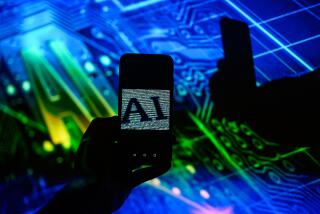Prosthetic hand with feeling: Re-creating the brain-hand connection

See how researchers were able to help amputee Dennis Aabo Sorensen feel objects in his grasp for the first time in nearly a decade.
- Share via
The human hand is a wonder of strength, sensitivity and discrimination — not only because of those four fingers and the opposable thumb, but also because of the human brain that controls it. No wonder, then, that for those who design hand prostheses, re-creating the natural dexterity of the brain-powered hand is a daunting challenge.
But a new study demonstrates that, with the aid of some artificial sensors and electrodes sunk into a user’s arm, a prosthetic hand can be made to detect the need for a firm grasp or a light touch, to make fine distinctions between an object’s texture, weight and size, and to respond accordingly with no detectable delay.
PHOTOS: A prosthetic hand, with feeling
The latest report, published Wednesday in Science Translational Medicine, marks another key step in the effort to enhance the function of prosthetic limbs by devising “brain-machine interfaces.” In bioengineering labs across the world, engineers and brain scientists are working to re-create the connection that once existed between the brain and the lost limb and transfer it to the new prosthetic limb.
By a variety of different methods, the researchers are trying to make prosthetic limbs that step, bend, reach or grasp in response to a user’s thoughts. Here, however, a team of engineers from France, Italy, the United Kingdom and Denmark worked together to make the communication between brain and prosthesis two-way.
The prosthetic hand could be directed to open and close at the conscious command of the user. But it could also send back to the user’s brain information about the touched object—details, for instance, about its size, weight, texture and density.
The aim of such “real-time bidirectional control,” as the authors of the current study put it, would allow prosthetic hand movements that are more natural, more dexterous and more responsive to a user’s needs. Allowing sensory input to temper motor commands would someday allow a prosthetic user to employ a different grasp to pluck an egg from a nest than she would to wield a hammer.
In a 36-year-old man who had his injured left arm amputated below the elbow 10 years before, the researchers tested their ability to restore the “user control loop.” Motor commands for a variety of different grasps, as well as for an open hand, made their way down the arm and were detected by sensors on the skin of the subject’s stump, then digitized and conveyed to the prosthetic hand. This capability is already making its way into broader use in prosthetics.
But returning sensory input from an artificial hand is a newer trick. To do so, the researchers implanted a suite of electrodes into two nerves embedded in the muscles of the subject’s upper arm. Electrodes sunk into the ulnar nerve carried sensory information from the subject’s prosthetic pinky finger to the brain—mimicking the routing that had once existed between his real little finger and his brain. Electrodes emplaced in the medial nerve became the conduit for tactile information from his prosthetic thumb and pointer (also called the index) finger—again, reproducing a pattern of signaling that had once existed between his original hand and his sensory cortex.
Those electrodes carried electrical charges in three different strengths, corresponding to sensors embedded in the prosthetic hand itself. The lightest contact with an object would set off the weakest charge detectable to the subject. A grasp that exerted increasing force on the sides of an object would set off a charge of increasing power, stopping just short of inducing a sensation of pain.
Four months and 700 trials later, the subject, who wore a blindfold and sound-canceling earphones during his test-runs, was not only able to close his hand around a variety of objects with a high degree of dexterity; he was also able to distinguish between a pack of cotton, a stack of plastic glasses and a piece of wood, and without any discernible delay, respond to those very different textures with different grips.
The subject began refining his use of the prosthetic hand almost immediately, and the researchers observed clear signs of growing “sensitivity” within a week of his trying the user control loop for the first time.
Having just two suites of electrodes to provide sensory feedback may provide a rudimentary level of information to a prosthesis user, the researchers said. But while that feedback might be made richer by using more electrodes, they wrote, the human brain may well, with experience, supply a lot of additional information about objects to be touched, grasped and manipulated.
In time, the 36-year-old amputee who served as the group’s subject became able to distinguish quickly—by prosthetic touch alone-- between such tricky paired objects as a mandarin orange and a baseball. His restored sensation appeared to induce an “artificial—albeit close to natural neural coding” that allowed him to learn quickly on his own and to use his growing intuition to fill in unknown properties of the objects his prosthesis touched.







